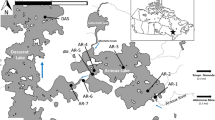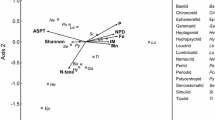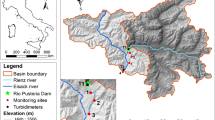Abstract
Biota and chemistry from hyporheic samplers were used to describe environmental changes, after treatment of mine drainage, in the shallow hyporheic zone in the upper Arkansas River, Colorado, U.S.A. Samples were collected (1992–1997) from above and below the mine drainage source, and further downstream where a historically cleaner tributary enters the system. Hyporheic metal concentrations were high during spring runoff at the impacted site even after initiation of treatment, but declined after several years. Correspondence analysis and increased invertebrate taxa richness suggested that hyporheic macroinvertebrates were recovering at the previously impacted site. Differences in substrate between sites and high water flows in 1995 also appeared to affect hyporheic communities. High taxa richness and abundance, taxa unique from those found at the surface, and high concentrations of metals found in the shallow hyporheic zone suggests that sampling this zone is important for monitoring recovery of polluted streams.
Similar content being viewed by others
References
APHA, 1989. Standard Methods for the Analysis of Water and Wastewater. 17th edn.
Benner, S. G., E. W. Smart & J. N. Moore, 1995. Metal behavior during surface-groundwater interaction, Silver Bow Creek, Montana. Envir. Sci. Technol. 29: 1789–1795.
Biesinger, K. E. & G. M. Christensen, 1972. Effects of various metals on survival, growth, reproduction, and metabolism of Daphnia magna. J. Fish Res. Bd Can. 29: 1691–1700.
Bloom, S. A., 1994. The Community Analysis System 5.0. Ecological Data Consultants, Inc. Archer, Florida.
Bourg, A. C. M. & C. Bertin, 1993. Biogeochemical processes during the infiltration of riverwater into an alluvial aquifer. Envir. Sci. Technol. 27: 661–666.
Brunke, M. & T. Gonser, 1997. The ecological significance of exchange processes between rivers and groundwater. Freshwat. Biol. 37: 1–33.
Campbell, D. H., D. W. Clow, G. P. Ingersoll, M. A. Mast, N. E. Spahr & J. T. Turk, 1995. Processes controlling the chemistry of two snowmelt-dominated streams in the Rocky Mountains. Wat. Resour. Res. 31: 2811–2821.
Cao, Y., A. W. Bark & W. P. Williams, 1996. Measuring the responses of macroinvertebrate communities to water pollution: a comparison of multivariate approaches, biotic and diversity indices. Hydrobiologia 241: 1–19.
Chadwick, J. W. & S. P. Canton, 1984. Inadequacy of diversity indices in discerning metal mine drainage effects on a stream invertebrate community. Wat. Air Soil Pollut. 22: 217–223.
Clements, W. H., D. S. Cherry & J. Cairns, Jr., 1988. Structural alterations in aquatic insect communities exposed to copper in laboratory streams. Envir. Toxicol. Chem. 7: 715–722.
Dole-Olivier, M.-J., P. Marmonier & J.-L. Beffy, 1997. Response of invertebrates to lotic disturbance: is the hyporheic zone a patchy refugium? Freshwat. Biol. 37: 257–276.
EPA, 1983. Methods of chemical analysis of water and wastes. EPA-600/4–79–020, Environmental Monitoring and Support Laboratory, Cincinnati, Ohio.
Fraser, B. G. & D. D. Williams, 1997. Accuracy and precision in sampling hyporheic fauna. Can.J. Fish. aquat. Sci. 54: 1135–1141.
Fraser, B. G. & D. D. Williams, 1998. Seasonal boundary dynamics of a groundwater/surface-water ecotone. Ecology 79(6): 2019- 2031.
Gauch, H. G., jr., 1982. Multivariate Analysis in Community Ecology. Cambridge University Press, Cambridge, U.K.
Gibert, J., P. Marmonier, V. Vanek & S. Plénet, 1995. Hydrological exchange and sediment characteristics in a riverbank: relationship between heavy metals and invertebrate community structure. Can. J. Fish. aquat. Sci. 52: 2084–2097.
Gilpin, B. R. & M. A. Brusven, 1976. Subsurface sampler for determining vertical distribution of stream-bed benthos. Prog. Fish-C. 38: 192–194.
Hare, L., 1992. Aquatic insects and trace metals: bioavailability, bioaccumulation and toxicity. Crit. Rev. Toxicol. 22(5/6): 327- 369.
Hassage, R. L. & K. W. Stewart, 1991. Use of substrate volume and void space to examine the presence of three stonefly species (Plecoptera) among stream habitats. Entomol. Soc. Amer. 84: 309–315.
Hurlbert, S. H., 1984. Pseudoreplication and the design of ecological field experiments. Ecol. Monogr. 54: 187–211.
Jain, C. K. & D. Ram, 1997. Adsorption of lead and zinc on bed sediments of the river Kali.Wat. Res. 31: 154–162.
Khangarot, B. S. & P. K. Ray, 1989. Investigation of correlation between physicochemical properties of metals and their toxicity to the water flea Daphnia magna Straus. Ecotoxicol. Environ. Saf. 18: 109–120.
Kimball, B. A., 1991. Physical, chemical and biological processes in waters affected by acid mine drainage: from headwater streams to downstream reservoirs. In Mallard, G. E. & D. A. Aronson (eds), U.S. Geological Survey Toxic Substances Hydrology Program-Proceedings of the Technical Meeting, Monterey, California, March 11–15, 1991: U.S. Geological Survey Water-Resources Investigation Report 91–4034.Washington, D.C.: U.S. Government Printing Office: 365–370.
LaPoint, T. W. & J. F. Fairchild, 1992. Evaluation of sediment contaminant toxicity: the use of freshwater community structure. In Burton, G. A. Jr. (ed.), Sediment Toxicity Assessment. Lewis Publishers, Chelsea, MI: 87–110.
LaPoint, T. W., S. M. Melancon & M. K. Morris, 1984. Relationships among observed metal concentrations, criteria, and benthic community structural responses. J. WPCF 56: 1030–1038.
McNight, D. M., B. A. Kimball & K. E. Bencala, 1988. Iron photoreduction and oxidation in an acidic mountain stream. Science 240: 637–639.
McNight, D. M. & K. E. Bencala, 1990. The chemistry of iron, aluminum and dissolved organic material in three acidic, metalenriched, mountain streams, as controlled by watershed and instream processes. Wat. Resour. Res. 26: 3087–3100.
Mitsch, W. J. & K. M. Wise, 1998. Water quality, fate of metals and predictive model validation of a constructed wetland treating acid mine drainage. Wat. Res. 32: 1888–1900.
Mount, D. M., 1966. The effect of total hardness and pH on acute toxicity of zinc to fish. Airand Wat. Pollut. Int. J. 10: 49–56.
Munro, B. H., 1993. Correlation. In Munro, B. H. & E. B. Page (eds), Statistical Methods for Health Care Research, 2nd edn. J.B. Lippincott Co., Philadelphia: 173–192.
Nelson, S. M. & R. A. Roline, 1996. Recovery of a stream macroinvertebrate community from mine drainage disturbance. Hydrobiologia 339: 73–84.
Notenboom, J., S. Plénet & M.-J. Turquin, 1994. Groundwater contamination and its impact on groundwater animals and ecosystems. In Gibert, J., D. L. Danielopol & J. A. Stanford (eds), Groundwater Ecology. Academic Press, San Diego: 477–504.
Peckarsky, B. L. & K. Z. Cook, 1981. Effects of keystone mine effluent on colonization of stream benthos. Envir. Ent. 10: 864- 871.
Plenet, S. & J. Gibert, 1994. Invertebrate community responses to physical and chemical factors at the river/aquifer interaction zone I. Upstream from the city of Lyon. Arch. Hydrobiol. 132: 165- 189.
Richards, C. & K. L. Bacon, 1994. Influence of fine sediment on macroinvertebrate colonization of surface and hyporheic stream substrates. Great Basin Nat. 54: 106–113.
Roline, R. A., 1988. The effects of heavy metals pollution of the upper Arkansas River on the distribution of aquatic macroinvertebrates. Hydrobiologia 160: 3–8.
Rouch, R., A. Mangin, M. Bakalowicz & D. D=Hulst, 1997. The hyporheic zone: hydrogeological and geochemical study of a stream in the Pyrenees mountain. Int. Rev. ges. Hydrobiol. 82(3): 357–378.
Stanford, J. A., J. V. Ward & B. K. Ellis, 1994. Ecology of the alluvial aquifers of the Flathead River, Montana. In Gibert, J., D. L. Danielopol & J. A. Stanford (eds), Groundwater Ecology. Academic Press, San Diego: 367–390.
Triska, F. J., V. C. Kennedy, R. J. Avanzino, G. W. Zellweger & K. E. Bencala, 1989. Retention and transport of nutrients in a thirdorder stream in northwestern California: hyporheic processes. Ecology 70: 1893–1905.
Ugland, R. C., W. S. Maura, R. D. Steger & G. B. O'Neill, 1995. Water resources data, Colorado, Water year 1994, Volume 1. Missouri River Basin, Arkansas River Basin and Rio Grande Basin. U.S.G.S.WDR-CO-94-1.
Vervier, P., J. Gibert, P. Marmonier & M.-J. Dole-Olivier, 1992. A perspective on the permeability of the surface freshwatergroundwater ecotone. J. n. am. Benthol. Soc. 11(1): 93–102.
von Gunten, H. R., G. Karametaxas, U. Krähenbühl, M. Kuslys, R. Giovanoli, E. Hoehn & R. Keil, 1991. Seasonal biogeochemical cycles in riverborne groundwater. Geoch. Cosm. A. 55: 3597- 3609.
Ward, J. V. & N. J. Voelz, 1990. Gradient analysis of interstitial meiofauna along a longitudinal stream profile. Stygologia 5(2): 93–99.
White, D. S., 1990. Biological relationships to convective flow patterns within stream beds. Hydrobiologia 196: 149–158.
Williams, D. D. & M. R. Smith, 1996. Colonization dynamics of river benthos in response to local changes in bed characteristics. Freshwat. Biol. 36: 237–248.
Winger, P. V. & P. J. Lasier, 1991. A vacuum-operated pore-water extractor for estuarine and freshwater sediments. Arch. envir. Contam. Toxicol. 21: 321–324.
Zar, J. H., 1984. Biostatistical Analysis, 2nd edn. Prentice-Hall, Inc., New Jersey.
Author information
Authors and Affiliations
Rights and permissions
About this article
Cite this article
Nelson, S.M., Roline, R.A. Relationships between metals and hyporheic invertebrate community structure in a river recovering from metals contamination. Hydrobiologia 397, 211–226 (1999). https://doi.org/10.1023/A:1003734407788
Issue Date:
DOI: https://doi.org/10.1023/A:1003734407788




